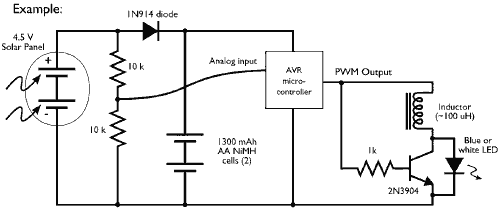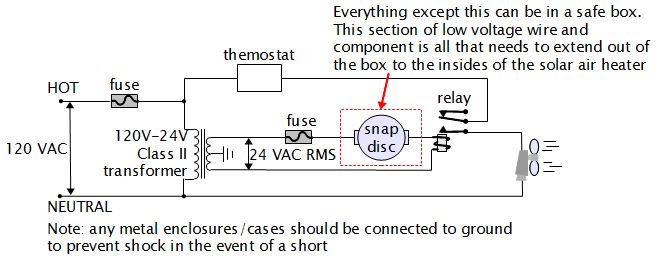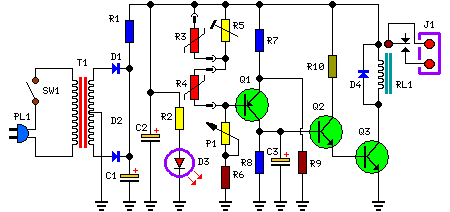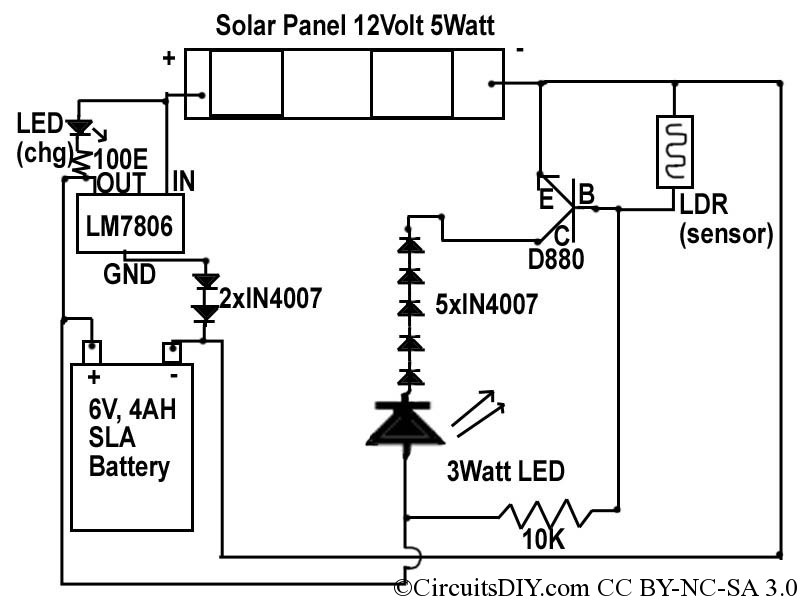
Non-Contact Proximity Switch Circuit

This circuit features a simple, highly sensitive capacitive ON/OFF switch pad that changes the state of a latch and activates an LED without requiring physical contact. The pad can be insulated, and a range of 12mm is easily achievable with adjustable sensitivity. Central to the design is the 74HC02 CMOS NOR Gate IC, which has a typical gate input capacitance of only 3pF. To ensure a sufficient voltage for reliable state changes, a 100M bias resistor is recommended. This resistor is readily available from suppliers such as DigiKey for approximately $0.52, or it can be fabricated using a series combination of 10M or 22M resistors to achieve a total of 50M. The low side of these resistors connects to a bias potentiometer, allowing the static gate input voltage to be set close to the threshold. Sensitivity can be further increased by reducing Vcc to 2.7V, with the minimum specified operating voltage being 2.0V. A range of about 16mm has been achieved using a 50M resistor and a paperclip as a non-contact pad.
Additionally, experimentation with the CD4011 NOR gate yielded reasonable results, though it has a higher gate input capacitance of 5pF and a minimum operating voltage of 3.0V. A 2N7000 N-Channel MOSFET (Q1) is used to drive a 20mA ultra-bright white LED. It is important to note that the gate output voltage may not fully turn on the transistor due to the maximum Vgs threshold voltage being 3V, although most devices operate close to the typical 2.1V. In case of failure, alternative devices may be tested. The pads can be insulated or positioned on the backside of a thin board, such as a canvas painting, which is the intended initial application. Another potential use is as an anti-theft deterrent or alarm that can be easily activated but not easily deactivated. A sensitive 6V relay with a back diode could also be driven by Q1, with DigiKey's PB1095-ND being a suitable choice. It is crucial to note that the closer the sensitivity potentiometer is set to the threshold, the higher the likelihood of accidental state changes due to electrostatic or electromagnetic disturbances. Therefore, it is advisable not to set the circuit for maximum performance, and it should not be used in critical applications.
The circuit design emphasizes the importance of component selection, particularly the bias resistor and the type of MOSFET used. The choice of the 74HC02 NOR gate IC is significant due to its low input capacitance, which is beneficial for capacitive sensing applications. The biasing arrangement allows for fine-tuning of the sensitivity, making it adaptable to various environmental conditions. Additionally, the option to insulate the pads opens up innovative applications beyond traditional electronics, potentially integrating this technology into everyday objects. The relay option adds versatility, enabling the circuit to serve dual purposes, including alarm systems. Overall, this capacitive switch design exemplifies a balance of sensitivity, reliability, and adaptability, making it suitable for various applications while maintaining simplicity in its implementation.Simple, highly sensitive capacitive ON/OFF switch pads change the state of a latch and turn on an LED without requiring actual physical human contact. The pad may be insulated. A range of 12mm is easily obtained and sensitivity is adjustable. Central is the 74HC02 CMOS NOR Gate IC. The gate input capacitance is typically only 3pF. To enable a suff icient voltage to change states reliably a 100M bias resistor is recommended. I had to check to see if such a resistor is easily available ” yes, it is available from DigiKey at a cost is only $0. 52. Or you can fabricate a resistor via series 10 or 22M resistors ” that is what I did to obtain 50M. The low sides` of these resistors are tied to a bias potentiometer so that the static gate input voltage may be set very close to the threshold.
Sensitivity is also increased by reducing Vcc to 2. 7V (minimum specified operating voltage is 2. 0V). I was able to obtain a range of about 16mm using a 50M resistor and paperclip non-contact pad. ` I also experimented with the CD4011 NOR gate ”it worked reasonably well, but it has higher gate input capacitance (5pF) and minimum operating voltage is also higher at 3. 0V. A 2N7000 N-Channel MOSFET (Q1) drives a 20mA ultrabright white LED. Note that the gate output voltage may be insufficient to fully turn on the transistor because the maximum Vgs threshold voltage is 3V.
Fortunately, most run close to the typical 2. 1V. In case one does not work, try another device. The pads may also be insulated or placed on the back side of a thin board such as a canvas painting etc ”this is the initial application. Another possibility would be an anti-theft deterrent/alarm that would be easily turned on, but not easily turned off.
A sensitive coil 6V relay with back diode may also be driven by Q1 ” DigiKey PB1095-ND would be a good choice. The closer the sensitivity pot is set to the threshold, the more probable that an electrostatic or electromagnetic disturbance will accidentally cause it to change states.
As a result, do not set for highest performance. Certainly, do not apply this circuit in critical applications. 🔗 External reference
Additionally, experimentation with the CD4011 NOR gate yielded reasonable results, though it has a higher gate input capacitance of 5pF and a minimum operating voltage of 3.0V. A 2N7000 N-Channel MOSFET (Q1) is used to drive a 20mA ultra-bright white LED. It is important to note that the gate output voltage may not fully turn on the transistor due to the maximum Vgs threshold voltage being 3V, although most devices operate close to the typical 2.1V. In case of failure, alternative devices may be tested. The pads can be insulated or positioned on the backside of a thin board, such as a canvas painting, which is the intended initial application. Another potential use is as an anti-theft deterrent or alarm that can be easily activated but not easily deactivated. A sensitive 6V relay with a back diode could also be driven by Q1, with DigiKey's PB1095-ND being a suitable choice. It is crucial to note that the closer the sensitivity potentiometer is set to the threshold, the higher the likelihood of accidental state changes due to electrostatic or electromagnetic disturbances. Therefore, it is advisable not to set the circuit for maximum performance, and it should not be used in critical applications.
The circuit design emphasizes the importance of component selection, particularly the bias resistor and the type of MOSFET used. The choice of the 74HC02 NOR gate IC is significant due to its low input capacitance, which is beneficial for capacitive sensing applications. The biasing arrangement allows for fine-tuning of the sensitivity, making it adaptable to various environmental conditions. Additionally, the option to insulate the pads opens up innovative applications beyond traditional electronics, potentially integrating this technology into everyday objects. The relay option adds versatility, enabling the circuit to serve dual purposes, including alarm systems. Overall, this capacitive switch design exemplifies a balance of sensitivity, reliability, and adaptability, making it suitable for various applications while maintaining simplicity in its implementation.Simple, highly sensitive capacitive ON/OFF switch pads change the state of a latch and turn on an LED without requiring actual physical human contact. The pad may be insulated. A range of 12mm is easily obtained and sensitivity is adjustable. Central is the 74HC02 CMOS NOR Gate IC. The gate input capacitance is typically only 3pF. To enable a suff icient voltage to change states reliably a 100M bias resistor is recommended. I had to check to see if such a resistor is easily available ” yes, it is available from DigiKey at a cost is only $0. 52. Or you can fabricate a resistor via series 10 or 22M resistors ” that is what I did to obtain 50M. The low sides` of these resistors are tied to a bias potentiometer so that the static gate input voltage may be set very close to the threshold.
Sensitivity is also increased by reducing Vcc to 2. 7V (minimum specified operating voltage is 2. 0V). I was able to obtain a range of about 16mm using a 50M resistor and paperclip non-contact pad. ` I also experimented with the CD4011 NOR gate ”it worked reasonably well, but it has higher gate input capacitance (5pF) and minimum operating voltage is also higher at 3. 0V. A 2N7000 N-Channel MOSFET (Q1) drives a 20mA ultrabright white LED. Note that the gate output voltage may be insufficient to fully turn on the transistor because the maximum Vgs threshold voltage is 3V.
Fortunately, most run close to the typical 2. 1V. In case one does not work, try another device. The pads may also be insulated or placed on the back side of a thin board such as a canvas painting etc ”this is the initial application. Another possibility would be an anti-theft deterrent/alarm that would be easily turned on, but not easily turned off.
A sensitive coil 6V relay with back diode may also be driven by Q1 ” DigiKey PB1095-ND would be a good choice. The closer the sensitivity pot is set to the threshold, the more probable that an electrostatic or electromagnetic disturbance will accidentally cause it to change states.
As a result, do not set for highest performance. Certainly, do not apply this circuit in critical applications. 🔗 External reference





